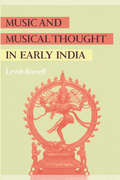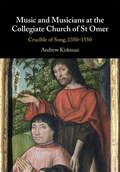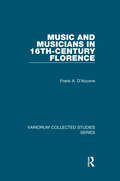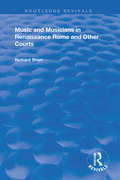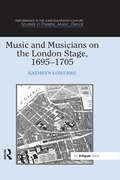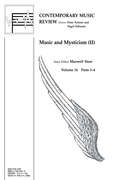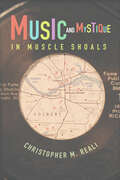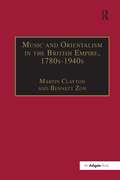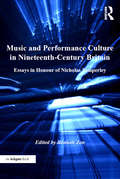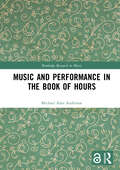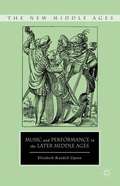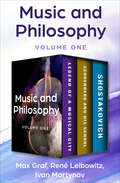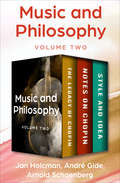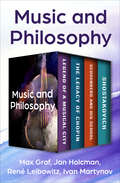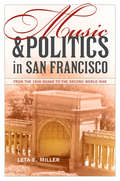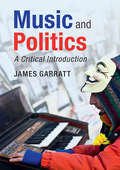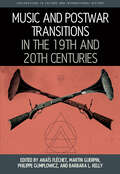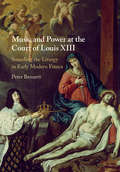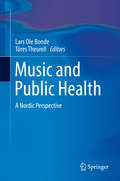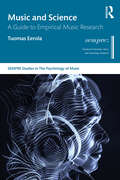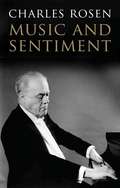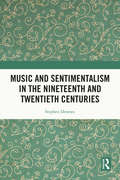- Table View
- List View
Music and Musical Thought in Early India (Chicago Studies In Ethnomusicology Ser.)
by Lewis RowellOffering a broad perspective of the philosophy, theory, and aesthetics of early Indian music and musical ideology, this study makes a unique contribution to our knowledge of the ancient foundations of India's musical culture. Lewis Rowell reconstructs the tunings, scales, modes, rhythms, gestures, formal patterns, and genres of Indian music from Vedic times to the thirteenth century, presenting not so much a history as a thematic analysis and interpretation of India's magnificent musical heritage. In Indian culture, music forms an integral part of a broad framework of ideas that includes philosophy, cosmology, religion, literature, and science. Rowell works with the known theoretical treatises and the oral tradition in an effort to place the technical details of musical practice in their full cultural context. Many quotations from the original Sanskrit appear here in English translation for the first time, and the necessary technical information is presented in terms accessible to the nonspecialist. These features, combined with Rowell's glossary of Sanskrit terms and extensive bibliography, make Music and Musical Thought in Early India an excellent introduction for the general reader and an indispensable reference for ethnomusicologists, historical musicologists, music theorists, and Indologists.
Music and Musicians at the Collegiate Church of St Omer: Crucible of Song, 1350–1550
by Andrew KirkmanMusic played an exceptionally important role in the late Middle Ages - articulating people's social, psychological and eschatological needs. The process began with the training of choirboys whose skill was key to institutional identity. That skill was closely cultivated and directly sought by kings and emperors, who intervened directly in recruitment of choirboys and older singers in order to build and articulate their self-image and perceived status. Using the documentation of an exceptionally well preserved archive, this book focuses on music's functioning in an important church in late Medieval Northern France. It explores a period when musicians from this region set the agenda across Europe, developing what is still some of the most sophisticated music in the Western musical tradition. The book allows a close focus not on the great achievements of those who cultivated this music, but on the personal motivations that shaped their life and work.
Music and Musicians in 16th-Century Florence (Variorum Collected Studies)
by Frank A. D’AcconeThis second selection of studies by Frank D’Accone, again based principally on the documentary evidence, follows the development through the mid 16th century of musical chapels at the Cathedral and the Baptistery of Florence and of musical establishments at the Santissima Annunziata and San Lorenzo. The lives, careers and works of composers associated with these churches are illustrated and their works analyzed, particularly the theoretical treatise by Fra Mauro, the madrigals of Mauro Matti and the ambitiously conceived canzone cycle of Mattia Rampollini. The final studies, moving into the 17th century, look at the music for Holy Week, and the unprecedented programme of performances at Santa Maria Novella.
Music and Musicians in Renaissance Rome and Other Courts (Routledge Revivals)
by Richard SherrFirst published in 1999, the essays that follow have been selected from the author’s writings to explore musical institutions in 15th and 16th century Italy with a detailed focus on the papal choir, but with additional comments on Mantua (Mantova), Florence and France. Much of the material which formed the basis of those essays was largely drawn from archives. Richard Sherr explores diverse areas including the Medici coat of arms in a motet for Leo X, performance practice in the papal chapel during the 16th century, the publications of Guglielmo Gonzaga, Lorenzo de’ Medici as a patron of music and homosexuality in late sixteenth-century Italy.
Music and Musicians on the London Stage, 1695-1705 (Performance In The Long Eighteenth Century: Studies In Theatre, Music, Dance Ser.)
by Kathryn LowerreFrom 1695 to 1705, rival London theater companies based at Drury Lane and Lincoln's Inn Fields each mounted more than a hundred new productions while reviving stock plays by authors such as Shakespeare and Dryden. All included music. Kathryn Lowerre charts the interactions of the two companies from a musical perspective, emphasizing each company's new productions and their respective musical assets, including performers, composers, and musical materials. Lowerre also provides rich analysis of the relationship of music to genres including comedy, dramatick opera, and musical tragedy, and explores the migration of music from theater to theater, performer to performer, and from stage to street and back again. As Lowerre persuasively demonstrates, during this period, all theater was musical theater.
Music and Mysticism: Parts 3 and 4 (Contemporary Music Review)
by Maxwell SteerThis title available in eBook format. Click here for more information.Visit our eBookstore at: www.ebookstore.tandf.co.uk.
Music and Mystique in Muscle Shoals (Music in American Life)
by Christopher M. RealiThe forceful music that rolled out of Muscle Shoals in the 1960s and 1970s shaped hits by everyone from Wilson Pickett and Aretha Franklin to the Rolling Stones and Paul Simon. Christopher M. Reali's in-depth look at the fabled musical hotbed examines the events and factors that gave the Muscle Shoals sound such a potent cultural power. Many artists trekked to FAME Studios and Muscle Shoals Sound in search of the sound of authentic southern Black music—and at times expressed shock at the mostly white studio musicians waiting to play it for them. Others hoped to draw on the hitmaking production process that defined the scene. Reali also chronicles the overlooked history of Muscle Shoals's impact on country music and describes the region's recent transformation into a tourism destination. Multifaceted and informed, Music and Mystique in Muscle Shoals reveals the people, place, and events behind one of the most legendary recording scenes in American history.
Music and Orientalism in the British Empire, 1780s-1940s: Portrayal of the East (Music In Nineteenth-century Britain Ser.)
by Bennett ZonFilling a significant gap in current scholarship, the fourteen original essays that make up this volume individually and collectively reflect on the relationship between music and Orientalism in the British Empire over the course of the long nineteenth century. The book is in four themed sections. 'Portrayal of the East' traces the routes from encounter to representation and restores the Orient to its rightful place in histories of Orientalism. 'Interpreting Concert Music' looks at one of the principal forms in which Orientalism could be brought to an eager and largely receptive - yet sometimes resistant - mass market. 'Words and Music' investigates the confluence of musical and Orientalist themes in different genres of writing, including criticism, fiction and travel writing. Finally, 'The Orientalist Stage' discusses crucial sites of Orientalist representation - music theatre and opera - as well as tracing similar phenomena in twentieth-century Hindi cinema. These final chapters examine the rendering of the East as 'unachievable and unrecognizable' for the consuming gaze of the western spectator.
Music and Performance Culture in Nineteenth-Century Britain: Essays in Honour of Nicholas Temperley (Music in Nineteenth-Century Britain)
by Bennett ZonMusic and Performance Culture in Nineteenth-Century Britain: Essays in Honour of Nicholas Temperley is the first book to focus upon aspects of performance in the broader context of nineteenth-century British musical culture. In four Parts, 'Musical Cultures', 'Societies', 'National Music' and 'Methods', this volume assesses the role music performance plays in articulating significant trends and currents of the cultural life of the period and includes articles on performance and individual instruments; orchestral and choral ensembles; church and synagogue music; music societies; cantatas; vocal albums; the middle-class salon, conducting; church music; and piano pedagogy. An introduction explores Temperley's vast contribution to musicology, highlighting his seminal importance in creating the field of nineteenth-century British music studies, and a bibliography provides an up-to-date list of his publications, including books and monographs, book chapters, journal articles, editions, reviews, critical editions, arrangements and compositions. Fittingly devoted to a significant element in Temperley's research, this book provides scholars of all nineteenth-century musical topics the opportunity to explore the richness of Britain's musical history.
Music and Performance in the Book of Hours (Routledge Research in Music)
by Michael Alan AndersonThis study uncovers the musical foundations and performance suggestions of books of hours, guides to prayer that were the most popular and widespread books of the late Middle Ages. Exploring a variety of musical genres and sections of books of hours with musical implications, this book presents a richly textured sound world gleaned from dozens of extant manuscript sources from fifteenth-century France. It offers the first overview of the musical content of these handbooks to liturgy and devotional prayer, together with cues that show scribal awareness for the articulation of sacred plainchants. Although books of hours lack musical notation, this survey elucidates the full range of musical genres and styles suggested both within and beyond the liturgical offices prescribed in books of hours. Privileging sound and ritual enactment in the experience of the hours, the survey complements studies of visual imagery that have dominated the category. The book’s interdisciplinary approach within a musical context, and beautiful full-color illustrations, will attract not only specialists in musicology, liturgy, and late medieval studies, but also those more broadly interested in the history of the book, memory, performance studies, and art history.
Music and Performance in the Later Middle Ages
by Elizabeth Randell UptonThis book seeks to understand the music of the later Middle Ages in a fuller perspective, moving beyond the traditional focus on the creative work of composers in isolation to consider the participation of performers and listeners in music-making.
Music and Philosophy Volume One: Legend of a Musical City, Schoenberg and His School, and Shostakovich
by Max Graf Ivan Martynov René LeibowitzThese three essential volumes on classical music theory and history explore the lives and contributions of some of music&’s greatest minds.In Legend of a Musical City: The Story of Vienna, renowned Austrian music critic Max Graf shares his recollections of life with Anton Bruckner, Gustav Mahler, Johannes Brahms, Richard Strauss, Arnold Schoenberg, and other immortals of the music world. Bringing to life several iconic composers as well as the city of Vienna itself, Graf recounts a charming, personal, and highly educational story of Austria&’s musical legacy.In Schoenberg and His School, noted composer, conductor, and music theorist René Leibowitz offers an authoritative analysis of Schoenberg&’s groundbreaking contributions to composition theory and Western polyphony. In addition to detailing his subject&’s major works, Leibowitz also explores Schoenberg&’s impact on the works of his two great disciples, Alban Berg and Anton Webern. In Shostakovich: The Man and His Work, Ivan Martynov presents a compelling and intimate biography of this pioneering legend. Martynov draws on extensive research, including interviews and conversations with Shostakovich himself, as well as his own expertise in the field of musicology.
Music and Philosophy Volume Two: The Legacy of Chopin, Notes on Chopin, and Style and Idea
by André Gide Jan Holcman Arnold SchoenbergThese three texts explore the power and potential of music by a renowned musicologist, a celebrated composer, and a Nobel Prize–winning author. Jan Holcman&’s The Legacy of Chopin is a comprehensive study of the great composer&’s views on music—including pianism, composition, pedagogy, criticism, and more. Drawing on extensive research from a wide range of sources, Holcman provides essential historical and musicological context for Frederic Chopin&’s references and concepts, making his more esoteric ideas accessible to the general reader. Nobel Prize winning author and devoted pianist André Gide presents inspiring discourse on the power of Chopin&’s music in Notes on Chopin. Gide depicts Chopin as a composer &“betrayed . . .deeply, intimately, totally violated&” by a music community that had fundamentally misinterpreted his work. Notes is a moving and poetic expression of profound admiration for a pioneering composer, and this edition includes rare pages and fragments from Gide&’s journals. In Style and Idea, Austrian composer and music theorist Arnold Schoenberg presents his vision of how music speaks to us and what it is capable of saying. Through a series of essays, Schoenberg discusses the relationship between music and language, new and outmoded music, composition in twelve tones, entertaining through composing, the relationship of heart and mind in music, evaluation of music, and other topics.
Music and Philosophy: Legend of a Musical City, Legacy of Chopin, Schoenberg and His School, and Shostakovich
by Jan Holcman Max Graf Ivan Martynov René LeibowitzFour classic works that explore the lives and contributions of some of the greatest minds in classical music—essential reading for any classical music fan. In Legend of a Musical City, renowned Austrian music critic Max Graf shares his recollections of life with Anton Bruckner, Gustav Mahler, Johannes Brahms, Richard Strauss, Arnold Schoenberg, and other immortals of the music world. Bringing to life some of the most iconic figures in music as well as the city of Vienna itself, Graf recounts a charming, personal, and highly educational story of Austria&’s musical legacy. Jan Holcman&’s The Legacy of Chopin is a comprehensive study of the great composer&’s views on music, including pianism, composition, pedagogy, criticism, and more. Drawing on extensive research from a wide range of sources, Holcman provides essential historical and musicological context for Chopin&’s references and concepts, making his more esoteric ideas accessible to the general reader. In Schoenberg and His School, noted composer, conductor, and music theorist René Leibowitz offers an authoritative analysis of Schoenberg&’s groundbreaking contributions to composition theory and Western polyphony. In addition to detailing his subject&’s major works, Leibowitz also explores Schoenberg&’s influence on the works of his two great disciples, Alban Berg and Anton Webern. In Shostakovich: The Man and His Work, Ivan Martynov presents a compelling and intimate biography of this pioneering legend. Martynov draws on extensive research, including interviews and conversations with Shostakovich himself, as well as his own expertise in the field of musicology.
Music and Poetry in a Colombian Village: A Tri-Cultural Heritage
by George ListThe history and an analysis of the folk music and poetry from the small village in Colombia.
Music and Politics in San Francisco: From the 1906 Quake to the Second World War
by Leta E. MillerThis lively history immerses the reader in San Francisco's musical life during the first half of the twentieth century, showing how a fractious community overcame virulent partisanship to establish cultural monuments such as the San Francisco Symphony (1911) and Opera (1923). Leta E. Miller draws on primary source material and first-hand knowledge of the music to argue that a utopian vision counterbalanced partisan interests and inspired cultural endeavors, including the San Francisco Conservatory, two world fairs, and America's first municipally owned opera house. Miller demonstrates that rampant racism, initially directed against Chinese laborers (and their music), reappeared during the 1930s in the guise of labor unrest as WPA music activities exploded in vicious battles between administrators and artists, and African American and white jazz musicians competed for jobs in nightclubs.
Music and Politics: A Critical Introduction
by James GarrattThis book is not about music or politics. It is about the 'and' that binds them together. How do these fields intersect, and what theories and approaches can help us understand their interactions? How have the relationships between music and politics changed over time and across cultures, and are the familiar tools we use in dealing with them fit for purpose? This book overhauls our understanding of how these fields interact, offering a rigorous reappraisal of key concepts such as power, protest, resistance, subversion, propaganda, and ideology. It explores and evaluates a wide range of perspectives from contemporary political theory, engaging with an array of musical cultures and practices from medieval chant to rap. In addition, it discusses current ways in which the relationships between music and politics are being reconfigured and reconceptualised. Where else can you find Donald Trump, Kendrick Lamar and Beethoven under one cover?
Music and Postwar Transitions in the 19th and 20th Centuries (Explorations in Culture and International History #10)
by Anaïs Fléchet, Martin Guerpin, Philippe Gumplowicz, and Barbara L. KellyFrom the Napoleonic Wars to the genocide of the Tutsis in Rwanda, via the great world conflicts of the 20th century, Music and Postwar Transitions in the 19th and 20th Centuries is the first book to highlight the significance of ‘postwar transitions’ in the field of music and to demonstrate the influence that musicians, composers, critics, institutions, and publics have had on the period that follows conflict. Leading historians, political scientists, psychologists and musicologists explore the roles of music and culture in demobilization, reconstruction, memory, reconciliation, revenge, and nationalist backlash. Moving beyond the popular conception of music as an agent of peace, this study reveals music’s more complex and ambivalent role in the process of transition from war to peace.
Music and Power at the Court of Louis XIII: Sounding the Liturgy in Early Modern France
by Peter BennettWhat role did sacred music play in mediating Louis XIII's grip on power in the early seventeenth century? How can a study of music as 'sounding liturgy' contribute to the wider discourse on absolutism and 'the arts' in early modern France? Taking the scholarship of the so-called 'ceremonialists' as a point of departure, Peter Bennett engages with Weber's seminal formulation of power to consider the contexts in which liturgy, music and ceremonial legitimated the power of a king almost continuously engaged in religious conflict. Numerous musical settings show that David, the psalmist, musician, king and agent of the Holy Spirit, provided the most enduring model of kingship; but in the final decade of his life, as Louis dedicated the Kingdom to the Virgin Mary, the model of 'Christ the King' became even more potent – a model reflected in a flowering of musical publication and famous paintings by Vouet and Champaigne.
Music and Protest in 1968
by Beate Kutschke Barley NortonMusic was integral to the profound cultural, social and political changes that swept the globe in 1968. This collection of essays offers new perspectives on the role that music played in the events of that year, which included protests against the ongoing Vietnam War, the May riots in France and the assassination of Martin Luther King, Jr. From underground folk music in Japan to antiauthoritarian music in Scandinavia and Germany, Music and Protest in 1968 explores music's key role as a means of socio-political dissent not just in the US and the UK but in Asia, North and South America, Europe and Africa. Contributors extend the understanding of musical protest far beyond a narrow view of 'protest song' to explore how politics and social protest played out in many genres, including experimental and avant-garde music, free jazz, rock, popular song and film and theatre music.
Music and Public Health: A Nordic Perspective
by Lars Ole Bonde Töres TheorellFrom the Nordic countries (Denmark, Norway, Sweden and Finland) comes an exciting source of theoretical approaches, epidemiological findings, and real-life examples regarding the therapeutic and health-enhancing effects of music. Experts across fields including psychology, neurology, music therapy, medicine, and public health review research on the benefits of music in relieving physiological, psychological, and socioemotional dysfunction. Chapters link musical experiences (listening and performing, as well as involvement in movement, dance, and theatre) to a wide range of clinical and non-clinical objectives such as preventing isolation, regulating mood, reducing stress and its symptoms, and treating dementia. And the book’s section on innovative music-based interventions illustrates opportunities for incorporating musical activities into public health programs. Among the topics covered are: · Associations between the use of music, cultural participation and health-related outcomes in adult Scandinavian populations · Music practice and emotion handling · How music translates itself biologically in the body · Music as a forum for social-emotional health · Participation and partnership as core concepts in music and public health · Music therapy as health promotion for mothers and children at a public health clinic Music and Public Health will gain interested readers among researchers, teachers, students, and clinicians in the fields of music education and therapy, as well as researchers and students of public health who are interested in the influence of culture and the arts. The book also will be relevant to administrators in public health services.
Music and Riddle Culture in the Renaissance
by Katelijne SchiltzThroughout the Renaissance, composers often expressed themselves in a language of riddles and puzzles, which they embedded within the music and lyrics of their compositions. This is the first book on the theory, practice and cultural context of musical riddles during the period. Katelijne Schiltz focuses on the compositional, notational, practical, social and theoretical aspects of musical riddle culture c. 1450–1620, from the works of Antoine Busnoys, Jacob Obrecht and Josquin des Prez to Lodovico Zacconi's manuscript collection of Canoni musicali. Schiltz reveals how the riddle both invites and resists interpretation, the ways in which riddles imply a process of transformation and the consequences of these aspects for the riddle's conception, performance and reception. Lavishly illustrated and including a comprehensive catalogue by Bonnie J. Blackburn of enigmatic inscriptions, this book will be of interest to scholars of music, literature, art history, theology and the history of ideas.
Music and Science: A Guide to Empirical Music Research (SEMPRE Studies in The Psychology of Music)
by Tuomas EerolaMusic and Science provides an introduction and practical guidance for a scientific and systematic approach to music research. Students with a background in humanities may find the field hard to tackle and this accessible guide will show them how to consider using an appropriate range of methods, introducing them to current standards of research practices including research ethics, open access, and using computational tools such as R for analysis. These research methods are used to identify the underlying patterns behind the data to better understand how music is constructed and how we are influenced by music. The book focusses on music perception and the experience of music as approached through empirical experiments and by analysing music using computational tools spanning audio and score materials. The process of research, collaboration, and publishing in this area of study is also explained and emphasis is given to transparent and replicable research principles. The book will be essential reading for students undertaking empirical projects, particularly in the area of music psychology but also in digital humanities and media studies.
Music and Sentiment
by Charles RosenHow does a work of music stir the senses, creating feelings of joy, sadness, elation, or nostalgia? Though sentiment and emotion play a vital role in the composition, performance, and appreciation of music, rarely have these elements been fully observed. In this succinct and penetrating book, Charles Rosen draws upon more than a half century as a performer and critic to reveal how composers from Bach to Berg have used sound to represent and communicate emotion in mystifyingly beautiful ways. Through a range of musical examples, Rosen details the array of stylistic devices and techniques used to represent or convey sentiment. This is not, however, a listener's guide to any "correct" response to a particular piece. Instead, Rosen provides the tools and terms with which to appreciate this central aspect of musical aesthetics, and indeed explores the phenomenon of contradictory sentiments embodied in a single motif or melody. Taking examples from Chopin, Schumann, Wagner, and Liszt, he traces the use of radically changing intensities in the Romantic works of the nineteenth century and devotes an entire chapter to the key of C minor. He identifies a "unity of sentiment" in Baroque music and goes on to contrast it with the "obsessive sentiments" of later composers including Puccini, Strauss, and Stravinsky. A profound and moving work,Music and Sentimentis an invitation to a greater appreciation of the crafts of composition and performance.
Music and Sentimentalism in the Nineteenth and Twentieth Centuries
by Stephen DownesIn a wide-ranging study of sentimentalism’s significance for styles, practices and meanings of music in the nineteenth and twentieth centuries, a series of interpretations scrutinizes musical expressions of sympathetic responses to suffering and the longing to belong. The book challenges hierarchies of artistic value and the associated denigration of sentimental feeling in gendered discourses. Fresh insights are thereby developed into sentimentalism’s place in musical constructions of emotion, taste, genre, gender, desire, and authenticity. The contexts encompass diverse musical communities, performing spaces, and listening practices, including the nineteenth-century salon and concert hall, the cinema, the intimate stage persona of the singer-songwriter, and the homely ambiguities of ‘easy’ listening. Interdisciplinary insights inform discussions of musical form, affect, appropriation, nationalisms, psychologies, eco-sentimentalism, humanitarianism, consumerism, and subject positions, with a particular emphasis on masculine sentimentalities. Music is drawn from violin repertory associated with Joseph Joachim, the piano music of Chopin, Schumann, and Liszt, sentimental waltzes from Schubert to Ravel, concert music by Bartók, Szymanowski and Górecki, the Merchant-Ivory adaptation of The Remains of the Day, Antônio Carlos Jobim’s bossa nova, and songs by Duke Ellington, Burt Bacharach, Carole King, Barry Manilow and Jimmy Webb. The book will attract readers interested in both the role of music in the history of emotion and the persistence and diversity of sentimental arts after their flowering in the eighteenth-century age of sensibility.
